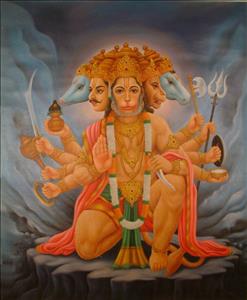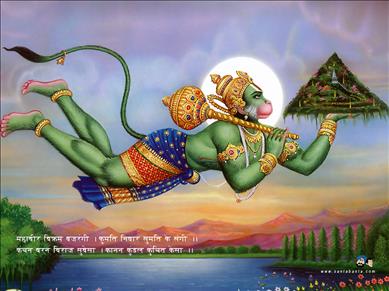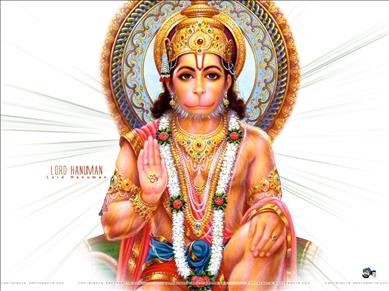Jaya Hanuman jnana guna sagara, jaya Kapisha tinhu loka ujagara,
Ramaduta, atulita baladhama, Anjaniputra, Pawanasuta nama.’
Victory to thee, O Hanuman, thou art the ocean of knowledge and virtue.
Victory to thee, O Lord of Monkeys, thou art known in all three worlds.
O Emissary of Rama, thou art the home of unparalleled might
Anjaniputra, Anjani’s son and Pawanasuta, son of the Wind God, art thy names.
Lord Hanuman, who possesses ocean-like unfathomable knowledge and virtue, incomparable might and earth-like steadfastness, is known and worshipped primarily as the Redeemer in crisis.
Ko nahi janat hai jaga mein Kapi Sankata-mochana nama tinharo
Who knows not in the world, O Monkey-God, Redeemer in crisis is thy name.
The laudation is least exaggerated. In theology or tradition of devotion, no God of any pantheon in India is venerated so much for redeeming in crisis as Hanuman.
As occasions of misfortune outnumber those of happiness in life, humankind looks more to him as redeemer from misfortune rather than as someone who bestows happiness.
Hanuman, the Redeemer, is hence more widely worshipped and has a larger number of shrines dedicated to him than even Rama, his Master.
Hanuman’s power to redeem is not a mere theological conceptualisation or a believer’s hypothesis, his life, as it reveals in different sources, is its example.
In Ramayana, the story of Rama’s life, which is broadly also the story of Hanuman’s life, this emissary and servant of Rama often rises above his Master at least in the face of a crisis.
Whatever Rama’s attributes as the Supreme God or Vishnu’s incarnation, when broken-heartedly he wandered in search of Sita, it was Hanuman who came to his support and aid.
The Saviour
He not only pledged to His cause and discovered Sita but also initiated efforts for her recovery by waging a psychological war against Ravana.
He put Lanka into flames leaving Lankans panicky and brought to Rama’s fold Ravana’s brother Vibhishana without whose aid Rama’s victory over Ravana would not have been easy.
When struck by the ‘Shakti,’ the divine weapon of Ravana’s eldest son Meghanatha, Lakshmana swooned and helpless Rama only wailed.
Hanuman not only lifted Ravana’s personal physician Susena ensconced in his house to cure Lakshmana but also brought Mountain Dron from the Himalayas with Sanjivini on it and saved Lakshmana’s life.
He rescued Rama and Lakshmana from Ahiravana’s custody just as they were about to be beheaded for sacrifice.
Bharata had pledged to end his life by immolating himself if Rama did not return to Ayodhya before Sunset on the day his 14 years of exile ended. Rama was delayed, but before Bharata entered the pyre, Hanuman rushed to Ayodhya and assured him that Rama would return soon.
Rama jasu jasa ap bakhana: It is true that Rama himself narrated Hanuman’s glorious deeds, but more notably, he called specifically for redeeming him and His brother from crisis.
When Ahiravana asked Rama and Lakshmana before beheading them to commemorate anyone they held in reverence, Rama asked Lakshmana to invoke Hanuman who alone could rescue them.
Patron Deity
This Redeemer of scripts is the protector of common folks. He is invoked by common masses for rescuing them from crisis and to protect them before any crisis occurs in their life.
His images are installed and worshipped invariably as the Protector and Patron Deity with the power to ward off misfortune.
He is ‘Kherapati,’ the Patron Deity of ‘Khera’ village and Ghatoria, the Protector of ‘ghats’ or valleys, to include river-crossings, descents, ascents, forts and village boundaries.
As ‘Balaji,’ he keeps evil spirits and maladies away and exorcises ghosts and ills from within. His name by itself has the status of the Mantra or hymn, which dispels evil, evil spirits and ghosts.
Bhuta pishacha nikata nahin abein: Ghosts and evil spirits dare not come around. As Bajaranga, with body made of ‘vajra,’ or as ‘Bajrangabali,’ he presides over gymnasiums and wrestlers’ rings infusing into their bodies his own might, agility and swiftness.
Protection from Planets
It is only Hanuman who wards off adverse influence of planets like Saturn and Rahu, protects people from failure in business, examinations, politics, sports and other fields.
A strange fusion of machine and faith is revealed when a road-roller, truck, locomotive engine, or a ship, painted with an icon of Hanuman or simply his name, passes unaffected by any mishap. Hanuman is believed to avert calamities at sea, rail-track and roads.
Parentage
Except that Hanuman was born to Anjana and that Anjana was married to Kesari, the monkey king of Sumeru, there is hardly any unanimity regarding the circumstances, date and day of his birth, pre-birth and childhood.
Despite that Kesari was Hanuman’s father, the legends of his birth evolves in such a way that Shiva and Wind God Maruta too seem to have been responsible for his birth.
In hymns devoted to him, Hanuman is often lauded with epithets like ‘Kesari Nandana’ (Kesari’s son), ‘Maruti Nandana’ (son of Maruta), ‘Pawana Suta’ (son of Pawana), another name for Wind God, and as ‘Rudra Rupa,’ manifest as Lord Shiva.
Kesari is alluded to unanimously as a mighty monkey possessed of exceptional wisdom. However, such unanimity is not seen in regard to Anjana.
In one of her accounts, she is said to be the daughter of Kesari, a demon.
The childless Kesari underwent great austerities to appease Lord Shiva for getting a son. Shiva however granted him a daughter, who would give birth to a strong and wise son.
She is sometimes identified as Indra’s celestial nymph Punjikasthala.
A Sage’s curse
Exceptionally beautiful but as much playful and naughty, she one day provoked a sage to curse that she would be born on Earth as a female monkey. Shaken with fear, Punjikasthala entreated the sage to forgive her but curses, like words, cannot be retrieved.
Punjikasthala was later born as the daughter of the saintly monkey king Kunjara who named her Anjana. When she was in her youth, she was married to Kesari.
As per yet another account, Anjana was born to Ahilya by sage Gautam.
Drawn by her bewitching beauty, one day Indra appears disguised as her husband. Sage Gautam sees them together and curses that she would remain unmarried in her entire life.
However, realising his error, he blessed her to have a son with extraordinary might and wisdom. The curse was thus averted.
Jain texts identify Anjana as an erstwhile celestial nymph born as the princess of Mahendrapur. Here both, Anjana and her husband Pavanajaya are alluded to as absolute human beings.
Confusing tales
Accounts of Hanuman’s birth and parentage in the Ramayana, Skanda Purana, Bhavishyottara Purana, Brahmananda Purana and some other texts are almost identical. The myth in the Brahmananda Purana begins with Anjana’s father Kesari, a demon. The childless Kesari underwent rigorous penance for a son.
Pleased, Lord Shiva appeared and asked him to name anything he wanted. Kesari asked him to grant him a son who was unparalleled on warfront and in might, wisdom and steadfastness. Shiva showed his inability, for Providence had not allowed him a son. He, however, granted him a daughter who would bear a mighty son.
In due course, his wife bore a girl with exceptional beauty.
Kesari named her Anjana. She was married to a mighty monkey, also named Kesari. They had no children for a long time.
One day, Dharma, God of Righteousness, disguised as a lowborn woman, adept in astrology, came to their place. She told Anjana that if she performed penance for 7000 years on Mount Venkatachala, she would have a mighty son. Following the long penance, she bore a son with unparalled valour, wisdom and strength.
Some other texts also allude to Anjana’s journey to Venkatachala for a son but on the advice of sage Matanga, not Dharma.
Sage Matanga saw Anjana engaged in rigorous austerities at mount Kishkindha. He asked her the object of her penance. A sad Anjana revealed her heart and entreated the holy saint to tell how she would get a son. Sage Matanga advised her to go to Venkatachala.
There she was asked to worship Lord Venkateshwara and take a dip in the sacred Akashaganga and drink a handful of its water. Purified, she stood and prayed to Wind God, who blessed her with a son, who would remain invincible by men, Gods and demons.
Nitin Kumar is Executive Editor of Exotic India, an online resource on Indian festivals, traditions, and religious observances. This Special Report carries his other stories. The above article, which appeared in our October 15 (Diwali Special) 2011, has been reproduced in view of the growing popularity of Lord Hanuman in New Zealand. Website: www.exoticindia.com

Hanuman is sometimes worshipped as the ‘Eleventh Rudra’ or Wind God

Hanuman flies with Mount Dron with life-saving Sanjivini

Hanuman has more temples than his Master Lord Rama






